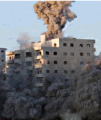Home > Rubriques > Languages - International > English > Facts Behind MFA Report on “Easing” of Gaza Closure
Source: Gisha : Center for Freedom of Movement ( en hébreu en 2ème partie de l’article)
Facts Behind MFA Report on “Easing” of Gaza Closure
Mardi, 21 septembre 2010 - 15h08
Tuesday 21 September 2010
===================================================
In advance of today’s meeting of the Ad-hoc Liaison Committee (AHLC) for assistance to the Palestinians, the Israeli Ministry of Foreign Affairs (MFA) released a report detailing steps taken to improve Gaza’s economy pursuant to a June 20, 2010 Israeli Cabinet decision to “ease” the closure.
The following is a summary of the main points of the MFA report and data which places the information in context.
True: “Traffic has increased significantly. The number of trucks coordinated with the PA normally reaches the current maximum capacity of 250 trucks a day”.
More True: While the volume of trucks has increased, it was still at just 38% of demand in the last month, due to Israel’s refusal to re-open crossings it has closed since 2007.
True: “Real GDP growth in the first half of 2010 (compared to the first half of 2009) is estimated by the IMF at 9 percent for the West Bank and 16 percent for Gaza”.
More true: The IMF report points out that growth is reflected in part because the first half of 2009, which included the military operation “Cast Lead” and its aftermath, represents a very low base or point of comparison. GDP per capita for Gaza is still 40% less than it was in 1994 and has yet to recover to 2007 levels, due to an apparently ongoing Israeli policy of “economic warfare”, including a ban on exports. The IMF has noted that true and sustainable economic recovery requires lifting the ban on exports and removing remaining restrictions on entrance of raw materials.
True: “Growth in the field of construction reached more than 20% in the first quarter of 2010 (in comparison to the parallel quarter in 2009)”.
More true: The parallel quarter in 2009 included the military operation “Cast Lead”, in which buildings were still being actively destroyed by the Israeli military. Due to onerous approval requirements and limited capacity of the crossings, just 132 truckloads of cement and gravel have entered Gaza since the “easing”, even though tens of thousands are needed. The UN notes, at this rate, it would take approximately 75 years to bring in the materials needed for UNRWA’s reconstruction plan.
True: “A number of projects have already been fully implemented or are currently underway. These projects include… Delivery of containers to serve as classrooms, a UN project”.
More True: Children in UNRWA schools attend classes in the aforementioned shipping containers, because despite the “easing”, Israel has yet to approve entry of a single truckload of construction materials for the 100 new schools UNRWA has requested to build.
True: “In July … a total of 2,457 exit permits were granted [to leave the Gaza Strip]”.
More true: This is less than 1% of the number of exits in Sept. 2000, before Israel imposed tight restrictions. Israel has announced that “[the easing] does nothing to expand the criteria [for travel]”.
==================
העובדות שמאחורי דו"ח משרד החוץ על ה"הקלות" על עזה
פורסם: יום שלישי, 21 בספטמבר 2010
לקראת כינוס ועדת הקישור אד הוק לסיוע לפלסטינים היום בניו-יורק, פרסם משרד החוץ הישראלי דו"ח המפרט את הצעדים שננקטו כדי לשפר את כלכלת עזה בעקבות החלטת ממשלת ישראל מיום 20 ביוני 2010 “להקל” את הסגר. להלן סיכום של הנקודות המועלות בדו"ח ונתונים נוספים שממקמים אותן בקונטקסט נכון יותר.
נכון: “התנועה גברה במידה ניכרת. מספר המשאיות המתואמות עם הרשות הפלסטינית מגיע בדרך כלל לקיבולת המקסימלית הנוכחית של 250 משאיות ביום.”
נכון יותר: הגם שנפח המשאיות גדל, מספר המשאיות הנכנסות הוא רק 38% מהביקוש בחודש האחרון, בגלל סירובה של ישראל לפתוח מחדש את המעברים שהיא סוגרת מאז 2007.
נכון: “קרן המטבע הבינלאומית מעריכה את צמיחת התוצר המקומי הגולמי במחצית הראשונה של 2010 (בהשוואה למחצית הראשונה של 2009) ב- 9% בגדה המערבית ו- 16% ברצועת עזה.”
נכון יותר: דו"ח קרן המטבע הבינלאומית מצביע על כך שנראית צמיחה בין השאר משום שהמחצית הראשונה של 2009, אשר כללה את המבצע הצבאי “עופרת יצוקה” ותוצאותיו, מהווה בסיס נמוך מאוד כנקודת השוואה. התוצר הלאומי הגולמי בעזה לאדם עדיין קטן ב- 40% ממה שהיה בשנת 1994 ועליו לצמוח עוד כדי להגיע לרמה של 2007, כתוצאה ממדיניות ישראלית נמשכת של “לוחמה כלכלית” הכוללת איסור על ייצוא. קרן המטבע הבינלאומית ציינה שהתאוששות כלכלית אמיתית וארוכת טווח מחייבת הסרת האיסור על ייצוא וההגבלות על כניסת חומרי גלם.
נכון: “הצמיחה בתחום הבנייה גדל ב- 20% ברבעון הראשון של שנת 2010 (בהשוואה לרבעון המקביל בשנת 2009).”
נכון יותר: הרבעון המקביל בשנת 2009 כלל את מבצע “עופרת יצוקה” שבו עדיין נהרסו בניינים באופן פעיל על ידי הצבא. הודות לתהליך אישור מסורבל ולקיבולת המוגבלת של המעברים נכנסו רק 132 משאיות עם מלט וחצץ מאז ה"הקלות", למרות שיש צורך בעשרות אלפים. האו"ם מציין כי בקצב הזה ידרשו 75 שנה לערך להכניס את כל החומרים שנדרשים עבור תוכנית השיקום של אונר"א.
נכון: “מספר פרויקטים כבר יושמו במלואם או שנמצאים בעיצומם. בין הפרויקטים נמנית ... חלוקת מכולות שישמשו ככיתות לימוד, פרויקט של האו”ם."
נכון יותר: ילדים בבתי הספר של אונר"א נאלצים ללמוד במכולות הללו בגלל שלמרות “ההקלות” ישראל עדיין לא אישרה את כניסתה של אף משאית אחת של חומרי בניין עבור 100 בתי הספר החדשים שאונר"א ביקשה לבנות.
נכון: “ביולי... הונפקו 2,457 אישורי יציאה [מרצועת עזה].”
נכון יותר: מספר זה הוא פחות מאחוז אחד ממספר היוצאים בספטמבר 2000, לפני שהטילה ישראל מגבלות חמורות. ישראל הודיעה כי “אין בהחלטה זו [על ההקלות] כדי להרחיב את הקריטריונים [ליציאה].”


